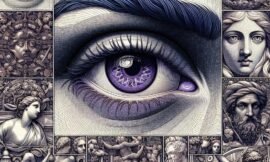Perspective in drawing is a vital skill that transforms flat surfaces into immersive worlds, allowing artists to create compositions with realistic depth and dimension. By understanding how to apply perspective techniques, you can elevate your art from simple representations to complex visual stories. Whether you’re a beginner eager to learn the ropes or an experienced artist looking to refine your skills, mastering drawing perspective is essential to achieving that three-dimensional effect on a two-dimensional canvas.
In this blog post, we delve deep into the strategies and insights needed to master perspective, focusing on techniques that will help you render accurate 3D forms and add a sense of depth to your art. Join us as we explore this artistic endeavor, appealing to both traditional art collectors and digital art enthusiasts.
Understanding the Basics of Perspective
The Concept of Vanishing Points
At the heart of perspective drawing lies the vanishing point. This is the spot on the horizon line where parallel lines appear to converge. Understanding the use of one-point, two-point, and even three-point perspective is crucial for artists who wish to create the illusion of depth effectively.
In one-point perspective, all parallel lines lead to a single vanishing point, ideal for drawings focused on a single scene or plane. Moving to two-point perspective adds complexity, employing two vanishing points and creating more dynamic compositions, often used for drawing exteriors and large objects. Finally, three-point perspective incorporates a third point, typically positioned above or below the object, often used for extreme perspectives such as a bird’s eye view.
The Horizon Line and its Significance
The horizon line is another fundamental aspect of perspective drawing. This imaginary line represents the viewer’s eye level and varies depending on the viewer’s height and distance from the object. Understanding and placing the horizon line effectively will guide the placement of vanishing points and ultimately influence the depth and dimensionality of your scene.
In landscape drawings, for instance, a low horizon line might give more room for depicting sky and tall objects, whereas a high horizon line emphasizes the foreground elements. This decision will significantly affect how your audience perceives the 3D forms within your composition.

Techniques for Enhancing Depth in Drawings
Layering and Overlapping
One of the simplest yet most effective ways to create a sense of depth in your drawings is through layering and overlapping objects. By strategically placing one object in front of another, the viewer’s eyes are directed to perceive depth as they navigate through the different layers.
This technique is often used in both traditional and digital art, allowing artists to guide the viewer’s attention through the scene. Additionally, overlapping can be employed alongside proportion adjustments where objects intended to appear further away are drawn smaller, enhancing the perception of 3D forms.
Utilizing Light and Shadow
Another critical aspect of rendering depth is the strategic use of light and shadow. Observing how light interacts with surfaces helps in accurately depicting shadows, which adds to the realism of your drawing.
By implementing gradients and varying shades, you can highlight and contour the form of objects, intensifying their three-dimensional appearance. Moreover, knowing where the light source is located in your composition will determine the length and direction of shadows, providing further clues about the spatial relationship between elements of your drawing.
Challenges and Solutions in Perspective Drawing
Avoiding Distortion in Perspective
One common challenge artists face is distortion, especially with objects positioned close to the vanishing points. This can lead to an unnatural appearance, detracting from the realism you strive to depict.
To overcome distortion, it’s important to maintain a balance between the vanishing points and how close objects are drawn. Regularly stepping back to view your piece as a whole can provide insights into adjustments needed to mitigate unwanted distortions in your 3D forms.
Finding the Right Perspective for the Scene
Choosing the correct type of perspective for your scene can be challenging, but it is crucial for conveying the desired ambiance and information. Begin by analyzing the primary focus of your artwork and the emphasis you wish to communicate.
If your piece revolves around a central object or structure, one-point perspective might suffice. Alternatively, for complex environments with many intersecting lines, two-point or three-point perspectives can provide a more engaging and dynamic arrangement. Experimentation is key, allowing you to find the right perspective that supports your artistic vision.
Advanced Perspectives in Modern and Digital Art
Dynamic Compositions in Digital Art
With the rise of digital art, perspective drawing has taken on new dimensions. Tools and software allow artists to experiment with complex perspectives more easily, including nonlinear and dynamic perspectives that weren’t feasible on paper.
Creators can push the boundaries of traditional perspective by using digital tools to simulate three-dimensional space, creating immersive compositions with interactive elements. This approach is prevalent in video games and animations, where perspective can shift dynamically, adding layers of interactivity and engagement.
Incorporating Perspective in Mixed Media
Contemporary artists often merge different media, incorporating perspective techniques to enhance depth and interest. From collages to installations, mixing traditional and digital elements can result in a rich visual experience that captures the audience’s interest.
Understanding how perspectives interact across various media is essential for artists who aim to blend styles and techniques seamlessly. Whether using traditional painting techniques alongside digital elements or mixing photography with hand-drawn sketches, mastering perspective can be the unifying thread that ties diverse elements into a cohesive whole.
Mastering perspective in drawing opens up a world of possibilities for artists, enabling the creation of dynamic compositions that resonate with viewers. By exploring techniques to render 3D forms and create depth, artists can transcend the flatness of the canvas and invite their audience into a believable and engaging world.
Whether you’re employing traditional methods or experimenting with digital innovations, understanding and applying perspective principles is crucial. As you continue to develop your artistic practice, remember that perspective is not just a technical skill but a powerful tool to enhance the storytelling quality of your art, bridging the gap between reality and imagination.






